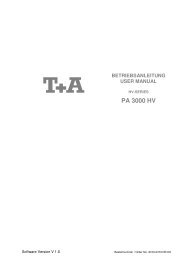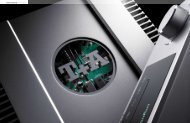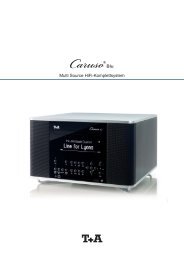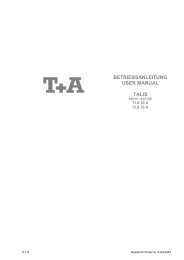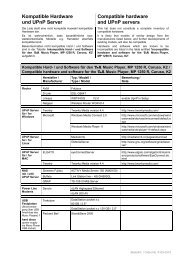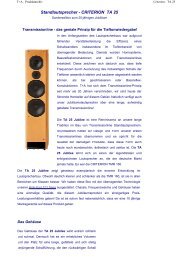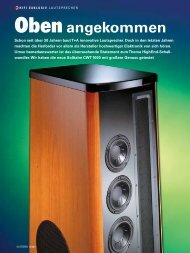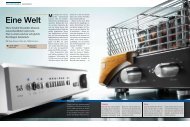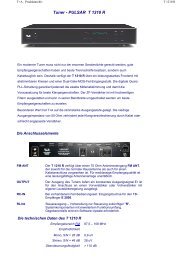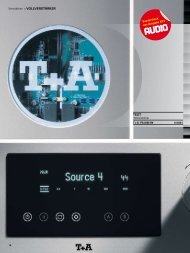Bedienungsanleitung - T+A Elektroakustik
Bedienungsanleitung - T+A Elektroakustik
Bedienungsanleitung - T+A Elektroakustik
Sie wollen auch ein ePaper? Erhöhen Sie die Reichweite Ihrer Titel.
YUMPU macht aus Druck-PDFs automatisch weboptimierte ePaper, die Google liebt.
Technical description<br />
Digital filters / Oversampling<br />
Oversampling The audio data on for example CDs is stored at a sampling rate of 44.1 -<br />
i. e. for each second of music 44.100 sampled values are available for each<br />
channel. In the DAC 8 the audio data read from the CD is „multiplied“ to a<br />
higher sampling rate (352,8 kHz) before it is converted back into analogue<br />
music signals. This process delivers a very much better, more finely<br />
graduated signal to the converter, which can then be converted with<br />
correspondingly higher precision. The raised sampling rate is a calculating<br />
process for which there are many different mathematical methods. In<br />
almost all digital audio devices which exploit the advantages of increased<br />
digital sampling rate a process known as a FIR filter is employed for this<br />
purpose. At we have been carrying out research for more than ten<br />
years, aimed at improving the oversampling process, because the standard<br />
FIR method has one drawback to set against its indisputable advantages: it<br />
adds small pre- and post-echoes to the music signals. At we have<br />
developed mathematical processes (known as Bezier polynomial<br />
interpolators) which do not share this disadvantage. For this reason they<br />
should sound better and more natural than the usual standard process.<br />
Since the calculating procedure employed by us is considerably more<br />
complex than the standard method, the DAC 8 features a highperformance<br />
digital signal processor (DSP) which carries out the oversampling<br />
process with immense precision (56 bit) using special algorithms<br />
developed by .<br />
The freely programmable DSP which we use is capable of carrying out the<br />
oversampling process using any method of calculation. For this reason we<br />
have implemented a slightly modified Bezier process (filters 3) in the DAC 8<br />
in addition to the pure Bezier process (filter 4), together with two variants of<br />
the standard process (filter 1 and filter 2). For more information on the<br />
different processes please refer to the next section. You can switch<br />
between the various algorithms, then decide for yourself which of the filters<br />
gives the results you prefer.<br />
Oversampling 1 (Standard FIR Filter)<br />
The long FIR filter is the standard oversampling process in digital<br />
technology, offering extremely linear frequency response, very high<br />
damping, linear phase characteristics and constant group delays. The<br />
disadvantage is the pre- and post-echoes which are added to the signal.<br />
These „time range errors“ tend to affect the music signal’s dynamics,<br />
precision and naturalness, and reduce spatial orientation.<br />
Frequency response and transient characteristics of the long FIR<br />
filter<br />
41



